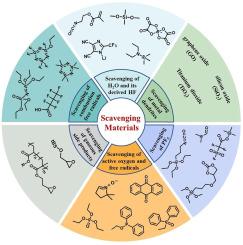Game changers: scavenging materials for nonaqueous rechargeable battery applications
IF 36.6
Q1 ELECTROCHEMISTRY
引用次数: 0
Abstract
Many potentially harmful reactive species are either present in nonaqueous rechargeable batteries or generated during their operation, with very negative effects on battery performance and/or safety. Scavenging materials have emerged as game changers, capable of directly eliminating and reducing the negative impact rendered by detrimental reactive species and thereby significantly improving battery performance and/or safety. This discussion introduces the origin of harmful species such as water and hydrofluoric acid, phosphorus pentafluoride, metal dendrites, combustion free radicals, active oxygen species and free radicals, as well as gaseous side products, and their adverse effects on battery performance and/or safety. We then describe and discuss scavenging materials having various structural characteristics and reaction chemistries with detrimental reactive species, as well as their positive role on battery performance and/or safety with respect to prominent nonaqueous rechargeable batteries, including lithium, sodium, zinc, and magnesium batteries. In addition, we outline the limitations of scavenging materials and the analysis techniques used in scavenging chemistry. The paper closes by offering perspectives on future development directions for scavenging chemistries in the realm of nonaqueous rechargeable battery applications. This comprehensive discussion will help to stimulate further advancements in novel scavenging materials for use in nonaqueous rechargeable battery applications.

游戏改变者:非水可充电电池应用的清除材料
许多潜在的有害反应物质要么存在于非水可充电电池中,要么在其运行过程中产生,对电池性能和/或安全性产生非常负面的影响。清除材料已经成为游戏规则的改变者,能够直接消除和减少有害反应物质带来的负面影响,从而显著提高电池性能和/或安全性。本讨论介绍了水和氢氟酸、五氟化磷、金属枝晶、燃烧自由基、活性氧和自由基以及气态副产物等有害物质的来源及其对电池性能和/或安全的不利影响。然后,我们描述并讨论了具有各种结构特征和具有有害活性物质的反应化学的清除材料,以及它们对电池性能和/或安全性的积极作用,包括锂、钠、锌和镁电池。此外,我们概述了清除材料的局限性和清除化学中使用的分析技术。论文最后提出了在非水可充电电池应用领域中清除化学物质的未来发展方向。这一全面的讨论将有助于促进用于非水可充电电池应用的新型清除材料的进一步发展。
本文章由计算机程序翻译,如有差异,请以英文原文为准。
求助全文
约1分钟内获得全文
求助全文

 求助内容:
求助内容: 应助结果提醒方式:
应助结果提醒方式:


